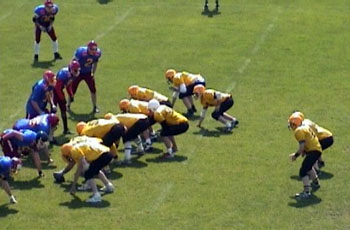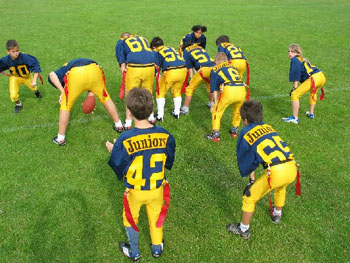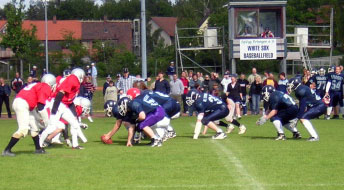Single Wing, German Style
August 30th, 2004
I’m one of the two coaches from the Erlangen Sharks. In Germany we play in spring, so our season is over and I can give you the complete results.
First Game
We won 34-6 against the Bavarian-State Wolverines
We rushed for 230 yards and scored one defensive touchdown.
Second Game
We won 48-0 against the Poppenroth Knights
We rushed for 294 yards and scored 34 points in the first quarter.
Third Game
We won 52-0 against the Knights
We rushed for 544 yards, and held the Knights offense to -13 yards passing.
Fourth Game
We lost 28-18 against the Hof Jokers
We rushed for 343 yards and outgained the Jokers by 100 yards on offense, but we made too many mistakes.
Fifth Game
We lost again 20-12 against the Wolverines
We lost about 80 yards due to bad snaps and rushed for only 75 yards, but we held the Wolverines to -2 yards total offense. We lost because of a bad snap recovered by the defense in our own endzone.
Last Game
We lost 34-0 against the Jokers
The Jokers were just too good that day. We rushed for 85 yards. This was the only game we got fewer total offense than our opponent.
Full statistics are on our team web page
Our single wing in a 8-man football tournament (indoor). Video can be found here.

This is the formation of the Goettingen Generals (the other single wing team in Germany. Yes there are only two teams)

Here in Germany we got some tournaments (indoor bowls) on indoor basketball fields. 8-man-football, the field: 50-yards long and about 20-yards wide. It’s nice!
Advantage
In Germany the single wing gives you a big advantage. Football in Germany is influenced by the NFL, in the worst way you can imagine. Every team plays I-formation and Spread, I know only one other single wing team and a handful of teams using Double Wing or Wing-T. None of our opponents could name our offense. There are not many coaches here who know what the single wing is all about. So most defenses have no clue how to defend the single wing, and the more they try the more they open up for big plays. Where would I be without it? No wins that’s for sure. The single wing fits our players so well, small linemen, good running backs and no hands!
The Plays
We got the basic package with an unbalanced line.
Off-tackle power
Sweep to long side
Fullback Dive
Fullback and Blocking Back Wedges
Wingback Reverse
Tailback Counter
Sweep Pass
Counter Pass
The Great Wall of China
(We tried a Fullback Spin series, but never really use it)
Where did I learn the offense?
That’s a nice story. I think it was fate. In 2000 I played as player against the Goettingen Generals, the other single wing team in Germany. We got slaughtered 78-18. We scored 18 points because we were bigger, stronger and more players, otherwise it would have been a shutout. In 2001 I bought a book on ebay. The seller called it “Old Football Book”. I bought it for about 15 dollars. I didn’t know what I got and the book landed on my “books-I-will-read-later” list. Half a year later I started reading and realized what I great book I got. I loved the ideas and the offense. The book I’m talking about is “Simplified Single Wing Football” by Ken Keuffel. And the rest is history. I still don’t know how the greatest football book (my opinion) found its way to me. I mean many coaches in the U.S. really want this book and a young coach in Germany got it. Must be fate. The other influence came from Coach Hugh Wyatt and his double wing. I played double wing as a player and coached it in my second year as a coach. And I use Severe Angle Blocking from Coach Gregory.
A story about me…there is one person, that has to be mentioned in this story. My friend, co-coach and mentor Mario Meissner. I’ll tell you my whole coaching/player biography, so you can see why Mario is so important to me.
I started with football in 1999 as a player. Before that I was only a NFL viewer. In 2000 Mario got the job of the defense coordinator. I was playing defense line, so Mario became my coach. This was Mario’s first coaching job. Mario told me if I ever started coaching I should read as many as I could get. Mario got fired in 2001 with 5 games left in the season, not because of his coaching, instead it was a dispute between him and the management.
In 2001 I started coaching. I coached a junior flag team (8-15 years old), and we finished 0-6. Late in the 2001 season I ruined my knee and my time as a player was pretty much over. In the off-season I persuaded Mario to coach the junior flag team with me. He agreed but he wanted to build up a junior tackle team (15-19 years old), too. Together we started a new season. Mario showed me one thing: the means of the internet. I visited the youth coaches forum, Coach Wyatt’s site, Derek Wade’s site and so on. I learned a lot, 1000 times more than I learned as a player.

Mario taught me how to scout a team with game tapes. Together we wrote our playbooks, he taught me that a playbook has to be simple, but complete. He learned how to coach, and I learned from him. That year we finished 3-3 with the junior flag team using the single wing (I read Ken Keuffel’s book that winter, after Mario said I shouldn’t leave a book like this unread). We also finished 3-3 with the junior tackle team using the double wing. And that’s the difference between the two of us — he is a Hugh Wyatt double winger, and I’m the single winger.

In the off-season Mario was fired again because of a me-first coach who wanted our sucessful junior tackle team after his own adult team went 0-8. Although I wasn’t fired, I left with Mario. We got hired by an adult team in Kummersbruck. We coached the double wing again and I coached the offense backfield. I also put the pads back on and played quarterback for two games and offense line for 4 games. It was a great experience to play in our own offense. We finished 3-6-1 with many injuries on key positions.

After the season with the Kummersbruck Red Devils in 2003, a new team was built in Mario’s hometown Erlangen by two brothers I played with in 2000. They really needed us, (so they said) so we left the Red Devils and we helped build the Erlangen Sharks. This time I could sell the single wing to Mario and we decided to mix Ken Keuffel with some double wing. You know we finished 3-3, but more important is the fact, that the players really identified with the single wing. The idea of old school football is part of our team identity.

The players see themselves as The Meat Grinder because of our strong running game. Mario played linebacker and blocking back this season, so I was alone on the sideline during the games. Mario trusted me to call the games. He trusted me with the single wing. Mario helped me from the beginning to become the coach I am. And he helps me to get better everyday. Mario Meissner is a great coach and friend and I admire him.
Greets,
Jens Loschke
Boilermaker at web dot de
The Single Wing Experience
August 16th, 2004
This article originally ran in the 2002 Pennsylvania Football Coaches Journal
My experience with the single wing began about 9 years ago when I was the head coach of the middle school program in Waynesboro, PA. I was running the I-formation and always looking for something that would allow our running backs to attack the flank as quickly as possible and with as much blocking support as we could muster. As luck would have it, I was working as a substitute at the time, and a friend and I were talking about football in general and he said, “If I was coaching football, I would use the single wing.” I had no clue what he was talking about and he proceeded to explain how every year he would go back home and watch the local high school team play. He talked about the spinning game, the buck lateral, and various traps and counters; I couldn’t get enough of it. I wanted more information! And so, with a little help from my mother-in-law (she was an assistant librarian at the time), she managed to find a copy of John Aldrich’s book: The Single Wing With the Spinning Fullback at a high school in York, PA of all places. With the help of my friend, we got in contact with coach Steve Isaacs of Bath County HS who just happened to be from his hometown in Virginia. He was more than willing to part with some of his playbook materials and a couple hours of game tape. At the time they had been using the single wing for about 7 or 8 years and had only one losing season, the first! They had never lost more than three games in any one season and every school they played was bigger (population) than they were.
I couldn’t wait to get home and watch the tape and was hooked 10 minutes into the film. The book and tape had everything I was looking for. Power, finesse, and simplicity were now at my fingertips. When I began researching the single wing more in depth, I tried to incorporate the three basic sets, Power, Spinners, and Buck Lateral series (according to Aldrich) into a flexible series of plays that could be used in nearly any down and distance situation. The head coach of the varsity program told me that he wanted the basics of his I-formation system installed, but I was free to experiment with anything I wanted. I started building my offense from two very simple formations and 6 plays based on the terminology of the I-formation. I called the formations “pro” and “slot” and everything was lined up from the right side. We ran sweep and off-tackle to the strong and quick sides, buck dive and the lateral, and spins that trapped the strong and quick sides. I realized that I could get as many as four men to the point-of-attack on any power sweep and no less than a double team on any inside power. We could trap just about any lineman or blitzing backer that showed between the tackles with as many as three different people (guard, tackle, or blocking back). Our spins and traps created the misdirection we needed to offset our powers. The great thing about this was that with the exception of two player’s alignments, there was very little difference in how our formation looked to the defense. I made a constant effort to give the defense the same look on nearly every play. In that first year, we played a six game schedule and managed to rack up 1,325 yards rushing and scored 19 touchdowns. By the end of the season we had incorporated motion into the mix and a short rotating no-huddle sequence that was so successful, that officials often asked us to slow things down. As a special note, we never started a game in the single wing; we never used it until at least our second or third series of downs. It was my thinking that we could surprise teams when we switched offense.
I have since developed my own playbook with several different formations and numerous variations. I have changed my base formation names from “pro” and “slot” to NOTRE DAME, which is my power series (named after the famed Knute Rockne and his Single Wing Box), SYRACUSE which simple denotes FB spin plays from the Nore Dame set, TULSA is my triple spin series, and WYOMING which is a spread style look. Each of these sets can be changed to gain a desired look by incorporating a handful of key terms that allow various position players to be moved. I have spoken with coaches and borrowed from others and absolutely love tinkering with the intricacies.
Over the years, changes have taken place and it has been extremely difficult to maintain support for the offense. I have had coaches laugh and smirk at my suggestions, while some have told me “That offense will never work in our league”, “Why don’t you like the I-formation or Wing T; they’re more versatile?” and “Why are you trying something that is so easy to defend, you line up the same way every time?” My answer has always been the same. “This offense has so much power is it ridiculous and the possibilities are endless. In the I-formation, you need a stud tailback or big line to make things happen. The Wing-T is nice, but there is nothing new for defenses that hasn’t been seen year in and year out. It has always been my position that if we can’t outrun or out muscle you, we will have to out-smart you, and I’ll take my chances with an offense that dominated the game for more than 50 years. That’s why I am fully convinced that I can beat you or any other team with the Single Wing.”
In the past 7 seasons, I have been through 3 varsity head coaches and their philosophies. We did use the offense exclusively during the 2001 season and doubled our previous year’s offensive production in both rushing and points scored. We used it at the J.V. level and had some exciting experiences including winning 3 games which hadn’t been done in 5 years and hasn’t happened since. Our record never reflected our improvements and some members of the staff were never sold on the Single Wing. After struggling in the beginning of the 2002 season, arguments and staff problems caused the Single Wing to disappear from our program and others vocabularies. The bottom line is that we never came close to testing its full merits.
The single most important message I would like to spread is that the Single Wing produces a level of unselfishness and fun for its players that simple can’t be overlooked. It has been my experience that the players I have coaches, have enjoyed “using” the offense because there are no privileged players; everyone must fake and everyone must block, or the team is unsuccessful. Finally, in all of my research, I have not found a single program that has adopted the Single Wing and not experienced some form of success, while several programs continue to have quite remarkable results. I have yet to speak with a coach who actually enjoys playing against this offense on a regular basis and because it is so unique, I promise that trying to prepare any team to defend it, is not a job they will enjoy.
John Minteer
Asst. Coach, Osbourn High School
Manassas, VA
jkcp at adelphia dot net